Content
- 1 How to care for a plant at home
- 2 How to plant correctly?
- 3 Reproduction methods
- 4 Proper maintenance in the garden
- 5 What can laurel be grown from?
- 6 Care and fertilization
- 7 How much is growing?
- 8 Bay leaf growing at home according to the rules
- 9 Types of indoor laurel
- 10 Reproduction of laurel
- 11 What kind of soil and pot is needed for a bay leaf
- 12 Reproduction of laurel seeds at home
- 13 Reproduction of laurel by cuttings at home
- 14 Laurel transplant at home
- 15 How to care for laurel at home
- 16 The healing properties of laurel
The use of bay leaves in cooking has become a tradition; no hot dish can do without it. But not many people know that you can grow bay leaves at home. It will perfectly enliven the home interior and fit into the landscape design of the garden area.
Laurel noble adapts to any place of stay. Some tricks and rules for caring for a plant make it possible to grow a beautiful green shrub even in the open field.
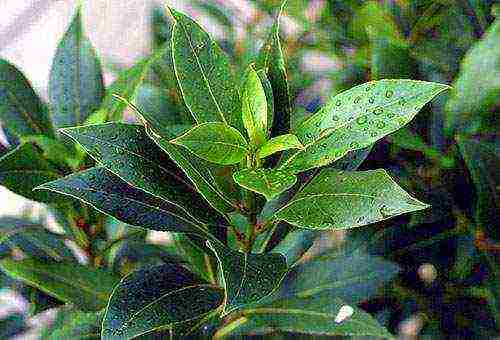
How to care for a plant at home
If you decide to grow laurel at home, you need to find a suitable place for it.
- You need to place the plant on a windowsill or on a flower stand, where there is a lot of light and sun. In the shade, the plant develops more slowly. Do not expose foliage to direct sunlight.
- Ventilate the room often to prevent discoloration and drying of the leaf tips.
- Water as the soil dries. The tree requires good drainage so that the root system does not rot from excess moisture. A refreshing shower and spraying will moisturize the crown and avoid pest infestation.
Advice
It is recommended to use a water solution with baking soda for watering. To prepare it, you will need 1 liter. running water and ½ teaspoon of soda.
- It is worth maintaining the average temperature in the room, not higher than 25 degrees, in the cold season, the laurel should arrange a winter period at home, when the temperature of the content is 10-14 degrees, and watering is reduced and carried out once every 2 weeks.

How to plant correctly?
The growth and development of the plant depends on the correct planting. Before starting, it is necessary to prepare all the components of the process: layering, pot, soil, mineral fertilizer, drainage, shovel.
- Take a small pot, because the plant develops slowly, and a large container will inhibit growth.
- Pour drainage on the bottom (2–3 cm). You can take expanded clay or ordinary foam, which must first be broken into small pieces.
- Prepare an earthen mixture: sand (1 part), peat soil (1 part), leafy soil (2 parts), turf soil (4 parts) - and fill the pot halfway.
- Place bay leaf in the middle, cover with mixture and tamp lightly.
- Water the plant with the diluted mineral complex.
The plant is transplanted at home into a new pot once every 2.5–3 years due to the slow development of the root system and the upper part.
An adult tree is transplanted once every 4 years or the top layer is renewed once every 2 years. In the warm season, the plant can be placed outdoors.

Reproduction methods
There are several ways to propagate a noble laurel at home:
- cuttings;
- planting seeds;
- separation of offspring.
Reproduction requires not only experience and skill, but also patience.
Cutting is one of the most time consuming methods, using a large, sturdy tree. To do this, you need to act according to the following algorithm.
- Separate the twigs with 4 internodes neatly with a utility knife or blade.
- Dip each of them in a substance for active growth of the root system (you can find it in any specialty store). Place in a container with water until roots form. Cuttings can be placed in moist perlite by covering the top with a glass jar. The plant must be periodically ventilated to prevent decay.
- After the roots appear, transplant into a ceramic or plastic pot.
Seed propagation is the longest process; seedlings may appear 60–65 days after planting.
Sowing should be carried out in early spring, as a soil, you can use a universal planting mixture. The seeds are placed at a depth of 1.5–2 cm, slightly moistened on top and covered with glass containers, which must be removed periodically to ventilate and moisten the soil.
Advice
Opt for fresh seeds that have been recently packed, because bay leaves tend to quickly lose germination quality.
Growing a leaf by separating the offspring is an easy and fast way to reproduce. When transplanting an adult plant, it is necessary to separate the “children” with roots from it and plant them in a separate small container.
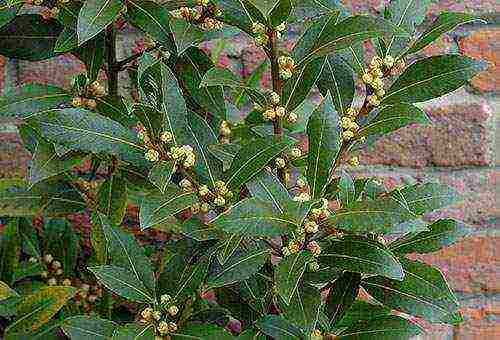
Proper maintenance in the garden
Average frost resistance allows you to grow shrubs in the open field or in a greenhouse. Bay leaves can freeze at temperatures below 13-15 degrees.
Advice
If, nevertheless, you took the risk of purchasing a plant in a region where the temperature in winter drops below this norm, plant it in a wooden tub or garden pot. This will transport the laurel to a warmer location.
Conditions that must be observed when growing in the garden:
- choose a sunny place for landing;
- neutralize the acidity of the soil;
- provide moderate watering;
- timely feed the plant.
This plant easily tolerates pruning, therefore it is a favorite shrub of experienced gardeners. In the southern regions, laurel hedges are common, which are given various interesting shapes and adjusted to the design concept.
Bay leaf is an unpretentious plant, it can be grown with pleasure at home, with little experience in floriculture.
By planting shrubs outdoors, you will get a versatile decorative element in your backyard. Simple rules for planting and caring for a plant will allow you to grow an environmentally friendly seasoning for culinary masterpieces at home.
How to grow bay leaves at home
Not a single housewife in her kitchen can do without bay leaves. We use this popular herb as an aromatic herb, as well as for medicinal and cosmetic purposes. It is very affordable and we can get it in any store. But it is much more pleasant to use the useful leaves of laurel, which is grown on your own windowsill!
Despite the fact that the Mediterranean lands are the birthplace of laurel, it develops perfectly in the conditions of our apartments. And already for 3-4 years of life, you can collect and dry leaves rich in valuable substances, essential oil and various acids. In addition, an adult plant looks very beautiful and can be a real decoration for your winter garden.
How to care?
Before figuring out how to grow a bay leaf at home, you need to understand whether you can provide the plant with the proper conditions. The tree itself can adapt to both sunny and darkened rooms. But if the house has a balcony, then in the summer it is advisable to take the plant out into the air. A garden or suburban area for this purpose would be the best option.In winter, place your laurel in a bright room.
Growing bay leaves does not require any special skills and knowledge. You just need to water the plant as the earthen coma dries up more often in summer, less often in winter, and spray the leaves with lukewarm water on the hottest days. Laurel should be watered with water at room temperature, he will not like cold water. And once a month, the plant should be fed so that it develops well and grows stronger. For this purpose, such concentrated mixtures as "Cactus" or "Palm" and the like are perfect.
Carbonate, light soil is what you need for planting laurel. In specialized stores you can buy ready-made mixture "Cactus", in which your plant will develop very well. From the moment of planting, you will have to replant the laurel every year in a new pot. When the tree reaches 5 years of age, you can change the land once in a four-year period.
Growing bay leaves from seeds
It is quite simple to grow laurel from seeds at home. Such a plant will adapt better to the new life, and will be able to develop well. Seeds are planted in the spring or fall. If you were able to get the seeds at the wrong time for germination, it is better not to risk it, and hide them for several months in a cold place, sprinkled with sand.
Seed growing takes place in several stages:
- To begin with, the seeds are placed in small boxes. The soil in these containers should consist of a sod, leaf mixture, mixed with sand (1: 1: 0.5). Before planting, the seeds are freed from the surrounding pulp, and at the end of the procedure, they are covered with glass (you can use plastic wrap).
- When your seeds germinate and give 2 leaves each, they can be transplanted into separate small pots (you don't have to buy ready-made containers in the store - used yogurt cups, etc.).
- The grown and matured plants are transplanted into ceramic pots until further growth.
Propagation by cuttings
If you do not know how to grow a bay leaf at home without seeds, then you can prepare cuttings for this purpose. The process of preparing cuttings should begin no earlier than March-April. Shoots are used only from a healthy bush that has already matured, but has not yet been covered with a crust.
Cuttings are cut into small pieces of 6-8 cm, observing some rules: when cutting off the cutting, you do not need to completely cut it off with a knife. Make an incision, and then gently tear off a piece to capture some of the crust. The stalk should have a heel starting below the first knot. Pouring at the bottom of the cutting is removed.
Growing bay leaves from cuttings is not an easy task. Cuttings root poorly, so it is recommended to use drugs that stimulate the process of root formation to form the root system. Before lowering the cuttings into the composition, they should be wetted. Something special is not required to remove excess preparation - you just need to shake off the cuttings.
The stalk prepared in this way is planted in a kind of greenhouse: under a plastic wrap supported by pegs, in clean sand, about 2 cm. in depth. You should wait for the rooting of cuttings no earlier than a month later. Then they can be planted in the ground.
An adult plant can be given absolutely any shape as a decoration for a room. You can trim your tree in the shape of a ball, or in the shape of an animal. Already from 2 years of age, the crown of a tree can be formed.
By growing a bay leaf yourself in your own apartment, you will not only get a wonderful decoration, but also a home remedy and an exquisite seasoning. We wish you every success!
Svetlana Frantseva "How to grow bay leaves at home" specially for the Eco-life website.
Photo: Alexey Korostiy
More about unusual home plants:
How to grow pineapple at home
How to grow a date palm from a seed
It is impossible to cook rich broth or fragrant stew without bay leaves. This is a really indispensable spice in the kitchen, appreciated not only for its pleasant smell, but also for its relatively low price. And yet, the process can be made cheaper by growing bay leaves right on the windowsill.
What can laurel be grown from?

Everyone is familiar with the appearance of bay leaves. What we see in the spice bag is an already dried processed material that is edible. In nature, laurel grows in warm southern regions. It belongs to both trees and tree-like shrubs. The height of a specimen developing in its natural environment sometimes reaches 18 - 20 meters, but this is a rarity.
The standard sample is about eight meters high, has a dense pyramidal crown and a thick trunk with dark gray bark. The laurel leaves, which are of particular value, are dense in structure, leathery, with a shiny surface and a well-defined oblong shape. Their distinctive feature is a strong spicy aroma.
Laurel reproduces in two main ways:
- By seed method;
- By cuttings.

Many are interested in how to grow bay leaves with cuttings, after studying the information presented on the Web tells them that this is the easiest way. We do not undertake to judge, but this procedure can cause a lot of trouble for an inexperienced gardener.
Cuttings for planting are cut from a large mature tree in mid-spring or closer to June. A suitable shoot has from two to three internodes, an elastic structure (without woodiness) and a length of 7 to 8 cm. He needs to shorten all the leaves.
The stalk is planted in the soil to a depth of one and a half centimeters. The distance from one planting to another is at least 10 cm. Rooting usually takes place one month after planting, provided that the ambient temperature remains between + 16 and + 20 ° C. When the seedlings grow roots, they are transplanted into separate pots.
How to grow bay leaves at home from a branch?
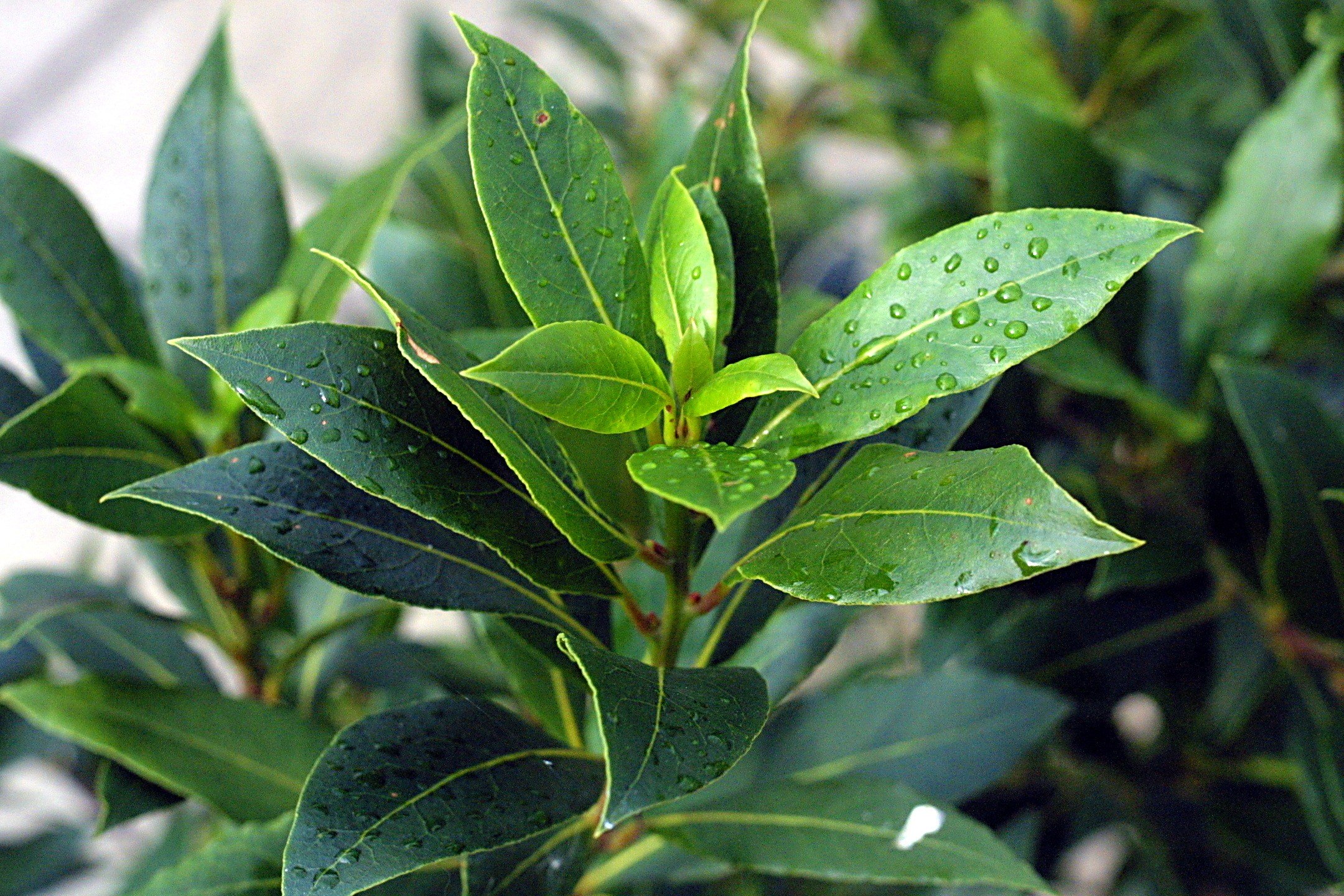
You can try to grow a bay leaf on a windowsill from a twig, but this method often fails. If you have at your disposal material obtained from a healthy mother bush, proceed as follows:
- A fresh green branch 15 - 20 cm long is divided into segments. Each part should have 2 - 3 leaves, the lower leaf blades are removed;
- The bottom of the cutting is cut at an oblique angle and placed in water for a couple of hours;
- The trimmed shoot is planted in a 0.5-liter plastic glass or plastic bottle without a neck. It is deepened into the ground to the level of the petiole of the preserved leaf;
- The planting is covered with a plastic bag to create a greenhouse effect;
- The stalk is sprayed 3-4 times a week and regularly ventilated.
After 7 - 15 days, the shoot should take root. When the roots get stronger, the cutting is transplanted to a permanent place in a nutritious substrate.
How to grow laurel at home from seeds?
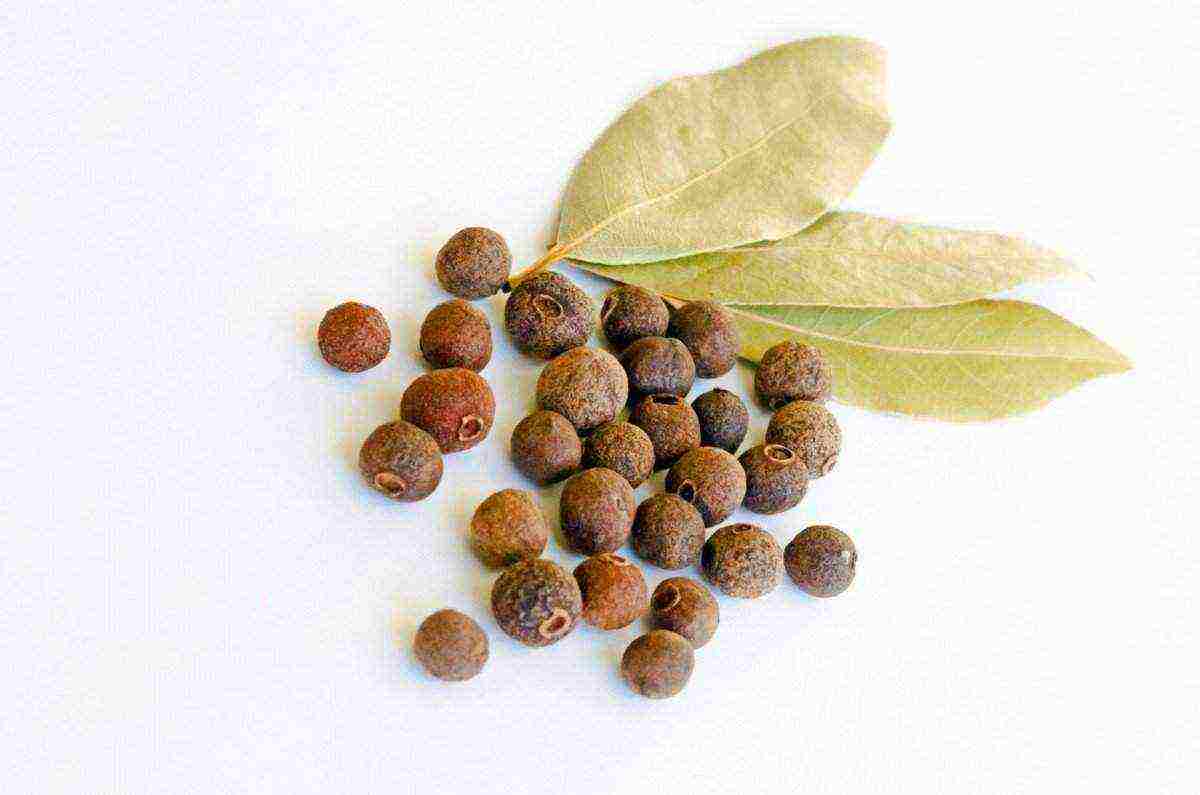
The practice of seed propagation of laurel by amateurs is usually not practiced. This is because this is a long process, the result of which is not always guaranteed. If you decide to take a chance, remember that sowing is carried out in late February or early spring. If desired, you can postpone sowing, keeping the seeds in a container of sand, tucked away in a cool, dark place.
Grow lavrushka from seeds at home not so easy. If you do not have the opportunity to collect berries, when choosing planting material, pay attention to its appearance. The seeds should be large, have a regular oval shape and a thin fleshy membrane. Do not use peeled seeds: they are stored less and may have already lost their germination.
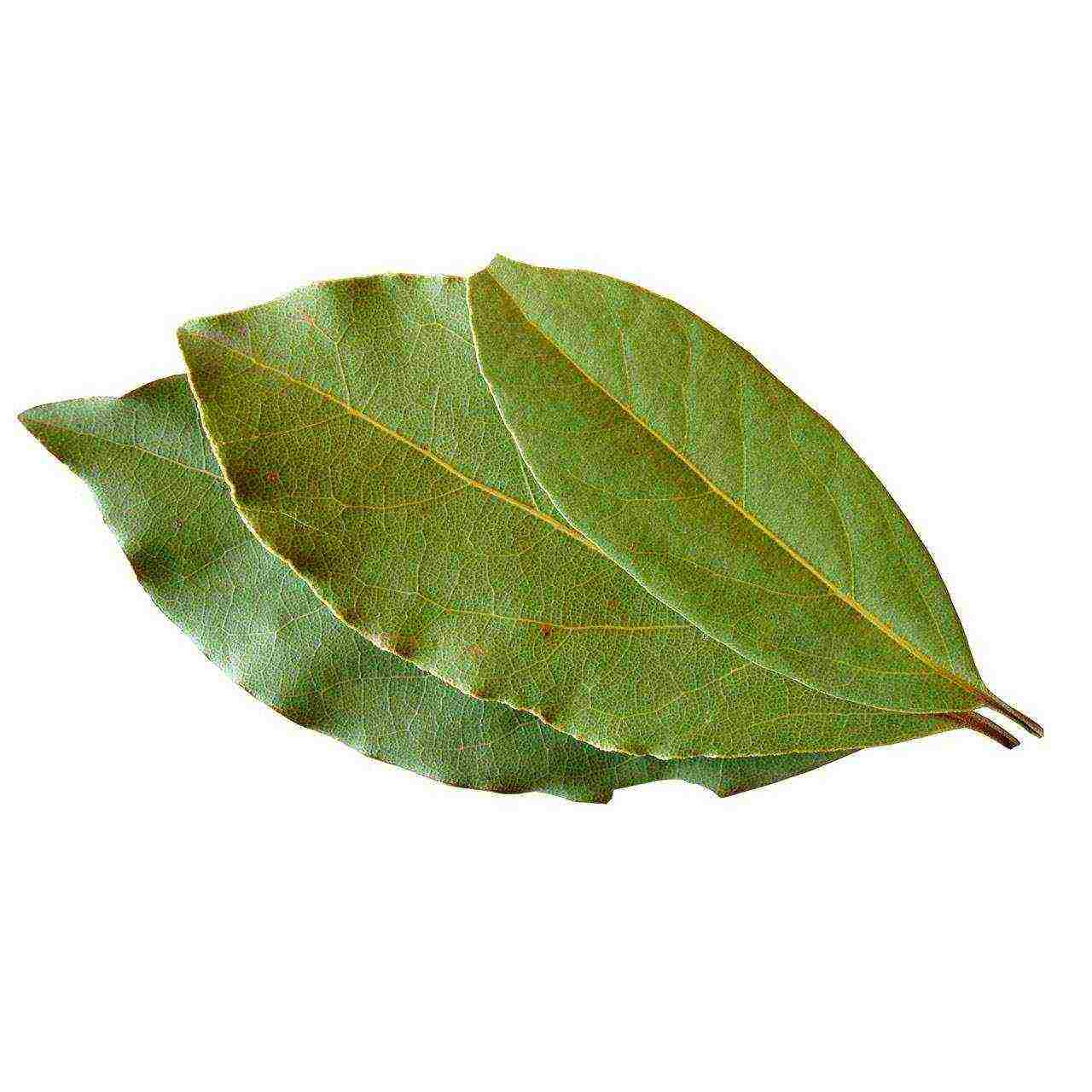
The soil mixture for planting is especially carefully prepared.An evergreen shrub in its natural environment prefers nutritious and loose soils, but does not take root well on acidic soils. The substrate should include leafy soil, humus, small amounts of turf, sand and peat. Add some wood ash to it to make the composition more neutral. For seeds, pots are taken with a diameter of 100 mm and a volume of 1 liter. Sometimes sowing is carried out directly into the open ground.
In order for the material to grow immediately, the peel (pericarp) is removed from the seeds before planting. It is not necessary to dry them, but soaking in a weak solution of potassium permanganate for 2 - 3 days can help. The seeds are buried in the soil to a depth of a centimeter, at a distance from each other. An earthen lump is spilled abundantly, and the planting is covered with a film on top. Seedlings should be on a warm, shaded windowsill.

Before the seedlings break through the soil, the protective cover (film or glass) is removed every day for 20 to 25 minutes. So the soil will not acidify, and the seedlings will receive the required amount of fresh oxygen. Spray it regularly to avoid drying out.
When the first shoots appear on the surface, the pots are transferred to a lighter corner. Watering mode is transferred to the scheme every 2 - 3 days, water is used only at room temperature. After the formation of 5 leaves, the seedlings are picked. Transplantation to a permanent place is carried out according to the same scheme as described above, but into a pot of larger volume and diameter.
Care and fertilization
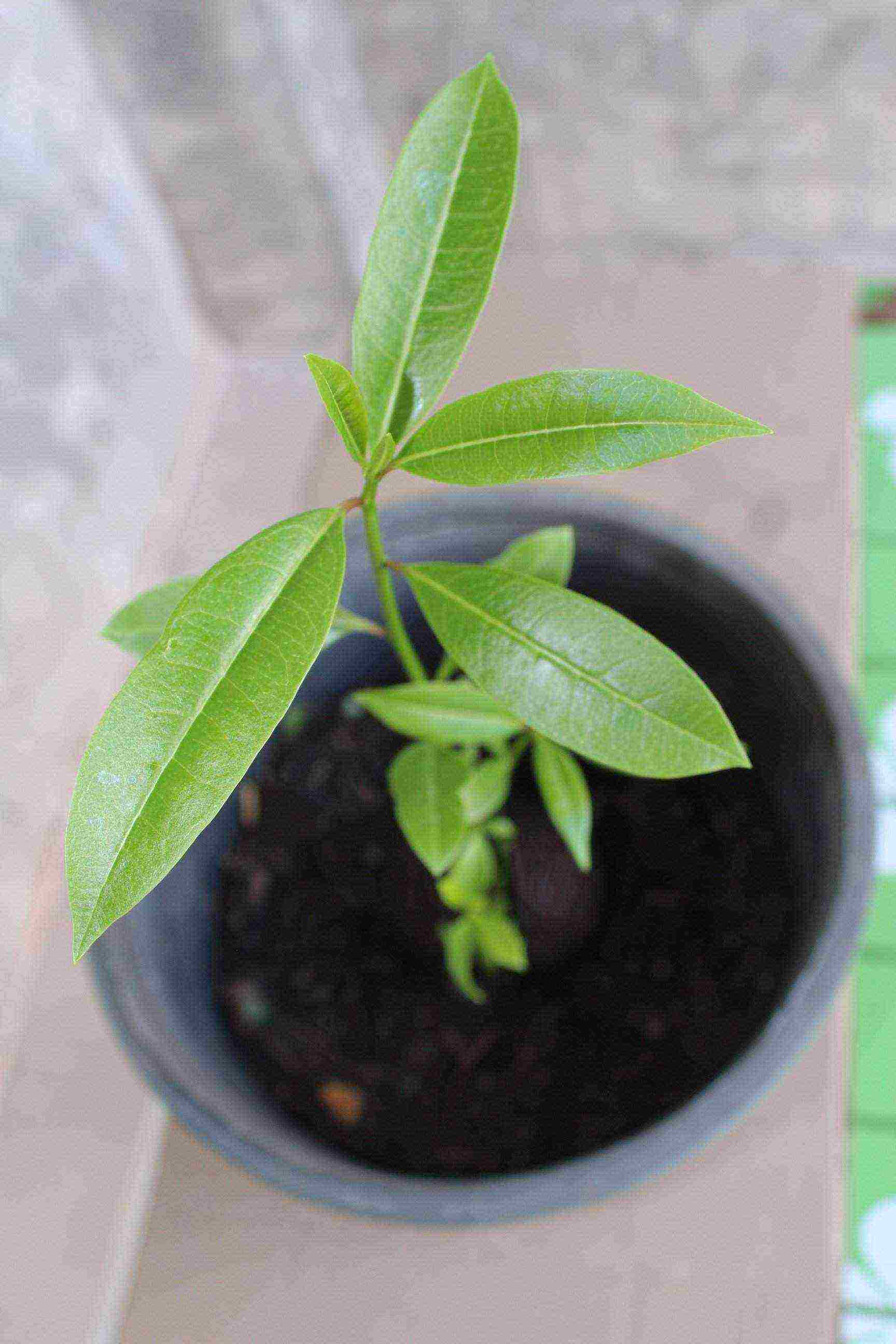
The correct maintenance of the plant both before and after seed germination is a guarantee of its successful development. Caring for laurel is not very difficult, but the implementation of some activities is essential.
- Lighting and temperature - bright light, south windows fit. It tolerates the direct rays of the sun well, but it is gradually taught to them. In winter, it is kept in a bright place at a moderate temperature regime (not lower than +12 ° C). The maximum air temperature in the summer months is not higher than +26 ° C;
- Watering - once every 2 - 3 days during the hot season and once during all winter months. Laurel loves moisture, so it is often sprayed. If the air in the apartment is dry, put the pot with the plant on a pallet, into which expanded clay is poured, and pour water into it;
- Fertilizers - the plant should be fed with preparations containing mineral preparations during the growing season. Organics are rarely used, especially at home;
- Pruning - the formation of the crown, if there is a desire to carry it out, is organized at the time of natural inhibition of laurel growth, that is, from mid-August and later. For spring pruning, remove the strong eyes at the top to maintain a beautiful shape longer;
- Transfer - for adults, the transshipment method is suitable, which allows not to injure the root system. It is carried out every 3-4 years, young seedlings need more frequent transplantation (once every 2 years). Remember to renew the drainage layer at the bottom of the pot or tub every time.
How much is growing?
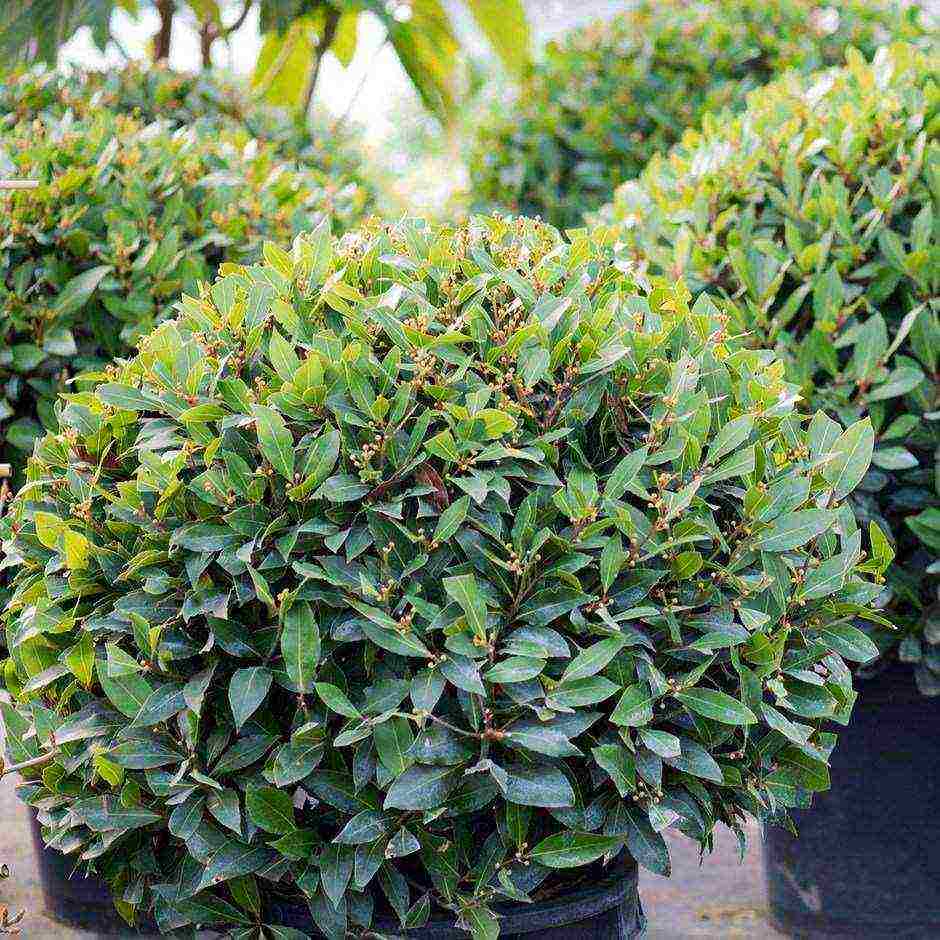
If you have a burning desire to grow a laurel tree from a seed, remember that the plant develops rather slowly. In nature, it can also celebrate a centenary, but at home, its life span is much shorter - from 15 to 20 - 25 years when creating the most comfortable conditions.
Bay leaf growing at home according to the rules
Bay leaf cultivation
Bay leaf cultivation
One of the most popular home-grown evergreens is the laurel flower. He may be a small bush or a miniature tree. In ancient times, laurel wreaths were worn on the heads of winners and famous people. This plant is very convenient to grow at home, because, in addition to decorative decoration of the apartment, it also has useful functions.There is no need to run to the store for a bay leaf, you just need to pluck it from the tree. We will talk about bay leaves, growing at home, and will be the topic of our conversation today.
Types of indoor laurel
This plant is subdivided into two groups:
- Noble;
- Canary.
Canarian laurel has wide, large leaves, the edges of which look somewhat wrinkled.
This species loses to the noble laurel in terms of the strength of its aroma.
The main botanical variety of laurel is divided into three types:
- Narrow-leaved;
- Golden;
- Wrinkly.
Each variety is characterized by the shape of the leaf and its color.
Reproduction of laurel
There are two ways to get your laurel tree:
- Growing bay leaves from seeds.
- Growing by rooting cuttings.
- Horizontal layering.
- Buying ready-made seedlings.
Let's consider some methods in more detail.
What kind of soil and pot is needed for a bay leaf
"Correctly" selected soil for a plant is a guarantee of its health and good development. Drainage is of great importance for laurel, so be sure to pour a drainage layer on the bottom of the pot (a special breed in the form of small pebbles, sold in flower shops).
It is best to choose a laurel pot from a natural material, be it clay or ceramics. Such material, unlike plastic, will not let the roots "suffocate". The bottom of the pot should have a sufficient number of holes so that the water leaves well and does not stagnate, provoking fungus, as well as rotting roots.
Soil for a bay bush will work all-purpose, any that you can find in a professional store. You can also prepare the mixture yourself, for this you will need:
- A piece of leafy land;
- Part of the turf land;
- Part of quartz sand;
- Part of the humus (can be replaced with compost).
IMPORTANT: All soil components are taken in an equal ratio of one to one quantity.
The reaction of the soil to acidity must necessarily be neutral, if you need to balance the acidity (this often happens when peat is present in the soil), add a little wood ash. The size of the pot depends on how you plan to grow laurel, the more you pick up the pot, the stronger the root system will grow, and therefore the bush itself.
Reproduction of laurel by seeds at home
When growing laurel from seed, there are two main difficulties: laurel seeds quickly enough, in 3-5 months, lose a significant percentage of germination and, due to the high content of oils, germinate very slowly, up to six months.
Therefore, the seed should be as fresh as possible, and to see the germinated seeds, you should be patient. Laurel is sown in January-February. To accelerate germination, the seeds are treated with a solution of a growth stimulator, and then planted to a depth of 1-1.5 cm in a moist light soil.
Cover with plastic wrap, keep at 18 degrees, regularly ventilate and maintain the moisture content of the substrate.
IMPORTANT! Monitor seeds for possible mold by monitoring their condition on a weekly basis. If a white bloom appears, remove it and wash the seeds in a weak solution of potassium permanganate.
Reproduction of laurel by cuttings at home
For vegetative propagation in this way, semi-lignified cuttings, which can be obtained from another plant, are ideal. If you do not have an adult donor laurel yet, then you can purchase the necessary parts separately.
Laurel cutting is usually carried out with the onset of the first warm days, cutting off the shoots in April or early June.
Some gardeners carry out the cutting process in late autumn, but in this case, you will not be able to plant the cuttings in a greenhouse or garden.
For harvesting cuttings, laurel branches taken from the middle or lower part of the shoots are cut into pieces of 6-8 cm each.Such a stalk should have at least three internodes (three free areas between the leaf attachment points) and an oblique cut at the bottom. The first leaves are completely removed, and the top ones are only slightly cut off, leaving half a leaf in order to minimize moisture evaporation.
Reproduction of laurel by cuttings can take place in two main ways: using a pre-prepared substrate or by rooting in ordinary water.
The ideal soil option for rooting laurel cuttings would be coarse sand, or a mixture of sand and peat. Sod land and sand are also often used (first, a layer of drainage is poured into the pot, then a layer of sod land, and a layer of sand is poured on top). After that, the resulting substrate must be well moistened and the cuttings should be planted to a depth of 1-1.5 cm according to the 10x10 scheme.
It's no secret that many indoor plants are often rooted in a regular jar or water bottle. All you need is to pour five centimeters of water into a jar and place a stalk in it. A jar of laurel is left in a dark place without changing the water (it can only be topped up).
Bay leaf cultivation
Planting rooted laurel cuttings is not much different from transplanting citrus plants, but you still need to know which soil is better to use and how exactly to "move" the plant to a new place of residence.
Transplanting laurel at home
Young, first five years of life, plants are transplanted, as a rule, every year, adults - once every 2-3 years, and then even less often.
The method of transplanting should be transshipment, in which the earthen lump is preserved as much as possible, and the new pot is not much larger, by 2-4 centimeters, larger than the old one in diameter.
How to care for laurel at home
If you decide to grow laurel at home, you need to find a suitable place for him. You need to place the plant on a windowsill or on a flower stand, where there is a lot of light and sun. In the shade, the plant develops more slowly. Do not expose foliage to direct sunlight. Ventilate the room often to prevent discoloration and drying of the leaf tips. Water as the soil dries.
The tree requires good drainage so that the root system does not rot from excess moisture. A refreshing shower and spraying will moisturize the crown and avoid pest infestation. For watering, it is recommended to use a water solution with baking soda. To prepare it, you will need 1 liter. running water and ½ teaspoon of soda. It is worth maintaining the average temperature in the room, not higher than 25 degrees, in the cold season, the laurel should arrange a winter period at home, when the temperature of the content is 10-14 degrees, and watering is reduced and carried out once every 2 weeks.
Laurel responds well to organic fertilizers... This could be, for example, pigeon droppings. It is diluted with water, preferably settled. For one part of the litter, take 20 parts of water. Laurel will also accept mineral fertilizers well. You can feed him once every three weeks.
Laurel
The healing properties of laurel
In addition to the fact that it is a fragrant, well-known seasoning, laurel also has a number of medicinal properties. This applies not only to the leaves, but also to the fruits. They contain aromatic essential oils and tannins.
So, inhalation of vapors of tinctures prepared from plant components helps to fight cancer. Also, experts say that laurel, which is properly carried out at home, can prevent the development of a disease such as coronary heart disease.


